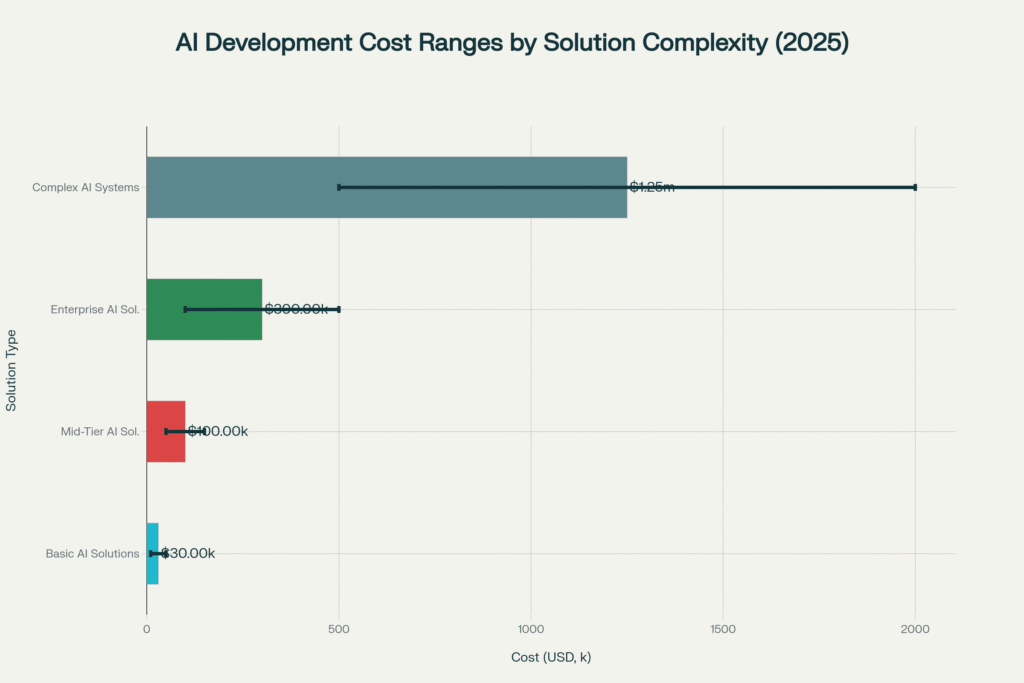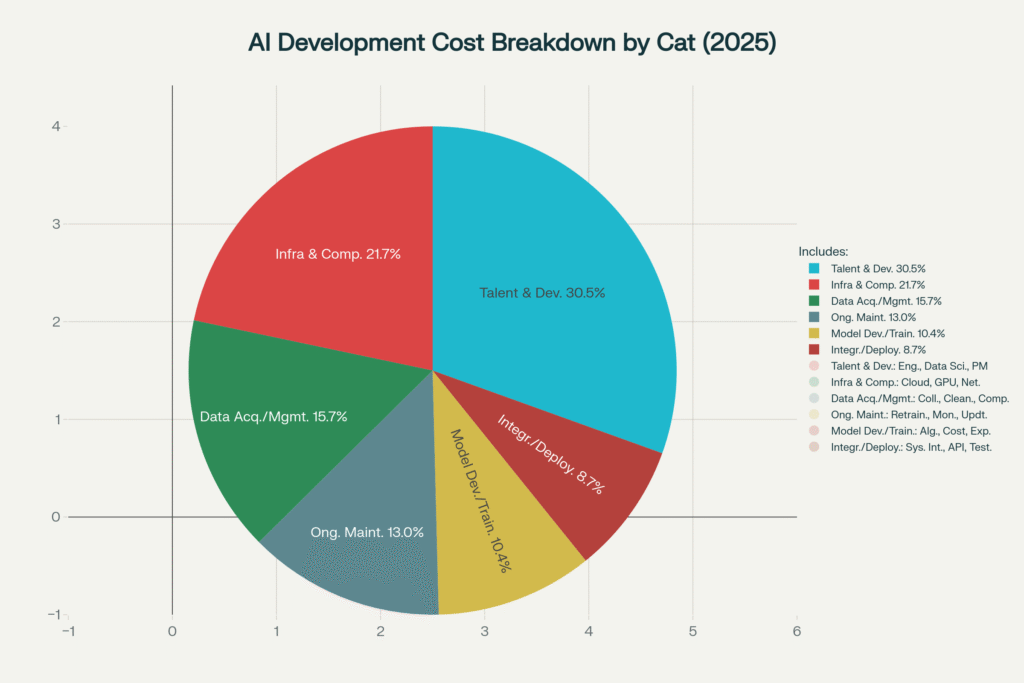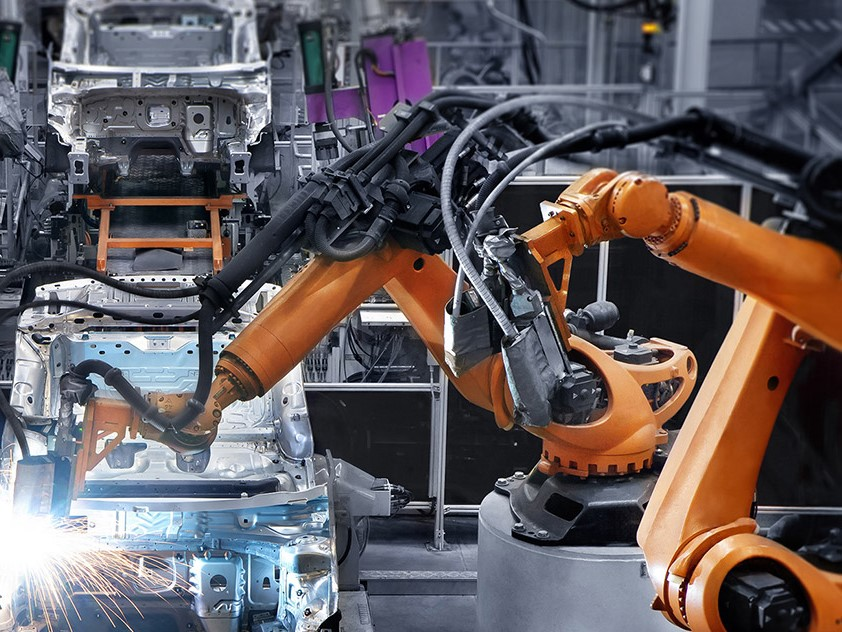

The Ultimate Guide to AI Implementation Costs in 2025: Complete Budget Planning & ROI Optimization
Artificial intelligence implementation has evolved from experimental pilot projects to mission-critical business investments, with AI spending surging to $13.8 billion in 2024—more than 6x the previous year’s $2.3 billion. As we enter 2025, understanding AI costs has become essential for business leaders planning digital transformation initiatives.
This comprehensive guide provides current pricing data, implementation strategies, and cost optimization techniques to help you make informed AI investment decisions that deliver measurable ROI.
Current AI Implementation Cost Landscape in 2025
Average AI Development Costs by Solution Type

AI Development Cost Ranges by Solution Complexity – showing typical investment ranges for different types of AI implementations in 2025
AI implementation costs in 2025 vary significantly based on complexity, scope, and business requirements. Here’s the current cost breakdown:
Basic AI Solutions ($10,000 – $50,000)
- Simple chatbots and virtual assistants
- Basic automation and rule-based systems
- Simple recommendation engines
- Sentiment analysis tools
- Timeline: 2-6 months
Mid-Tier AI Solutions ($50,000 – $150,000)
- Advanced conversational AI systems
- Computer vision applications
- Natural language processing solutions
- Predictive analytics platforms
- Timeline: 4-12 months
Enterprise AI Solutions ($100,000 – $500,000)
- Custom machine learning platforms
- Advanced predictive maintenance systems
- Comprehensive analytics solutions
- Multi-functional AI ecosystems
- Timeline: 6-18 months
Complex AI Systems ($500,000 – $2,000,000+)
- Autonomous decision-making systems
- Industry-specific AI platforms
- Large-scale generative AI implementations
- Mission-critical AI infrastructure
- Timeline: 12-24+ months
What’s Driving AI Costs Higher in 2025
Several key factors are pushing AI implementation costs upward:
Generative AI Adoption: Advanced chatbots and content creation tools require significantly more computing power, increasing costs by 15% compared to traditional ML solutions.
Talent Shortage: 46% of organizations identify skill gaps as a significant barrier, driving AI professional salaries to $100,000-$300,000 annually.
Compliance Requirements: The EU AI Act and similar regulations are adding 5-15% to project costs for compliance and ethical AI measures.
Infrastructure Demands: AI workloads consume exponentially more computational resources, with GPU instance costs running 15x higher than standard CPU instances.
Comprehensive AI Cost Breakdown

AI Development Cost Breakdown – showing how AI project budgets are typically allocated across different cost categories
Understanding where your AI budget goes is crucial for effective cost management. Here’s how successful organizations allocate their AI investments:
Talent & Development (35%)
The largest portion of AI budgets goes to human resources:
- AI Engineers: $120,000-$250,000 annually
- ML Engineers: $150,000-$300,000 annually
- Data Scientists: $100,000-$200,000 annually
- Project Management: $80,000-$150,000 annually
- Consulting Services: $170-$400 per hour
Infrastructure & Computing (25%)
Technical infrastructure represents the second-largest cost category:
- Cloud Computing: $500-$50,000+ monthly depending on scale
- GPU/TPU Resources: $2,000-$10,000+ monthly for training
- Data Storage: $25,000+ monthly for large datasets
- Networking & Security: Variable based on requirements
Data Acquisition & Management (18%)
High-quality data drives AI success but comes at a premium:
- Data Collection: $10,000-$100,000+ for custom datasets
- Data Cleaning & Preparation: Often 50% of development time
- Storage & Management: Ongoing monthly costs
- Compliance & Privacy: Additional security measures
Ongoing Maintenance (15%)
Post-deployment costs are often underestimated:
- Model Retraining: 20-50% of initial training costs
- Performance Monitoring: $1,000-$10,000+ monthly
- Updates & Improvements: Continuous investment required
- Technical Support: 24/7 monitoring capabilities
Model Development & Training (12%)
The core AI development process:
- Algorithm Development: Custom model creation
- Training Costs: Computational resources for model training
- Experimentation: Multiple iterations and testing
- Validation: Ensuring model accuracy and reliability
Integration & Deployment (10%)
Making AI operational in your business:
- System Integration: Connecting with existing platforms
- API Development: Creating interfaces for AI services
- Testing: Comprehensive quality assurance
- Deployment Infrastructure: Production environment setup
Industry-Specific AI Implementation Costs

AI costs vary significantly across industries due to regulatory requirements, data complexity, and specialized needs:
High-Cost Industries
Healthcare ($300,000 – $800,000+)
- Regulatory compliance (HIPAA, FDA approvals)
- Medical imaging and diagnostic AI
- Clinical decision support systems
- Real-world example: Cancer Center.AI’s pathology platform delivered higher productivity and reduced diagnostic errors
Financial Services ($300,000 – $800,000+)
- Fraud detection and prevention
- Risk management systems
- Algorithmic trading platforms
- Success story: Bancolombia achieved 30% increase in code generation with GitHub Copilot
Manufacturing ($400,000 – $800,000+)
- Predictive maintenance systems
- Quality control automation
- Supply chain optimization
- Industrial IoT integration
Moderate-Cost Industries
Transportation & Logistics ($500,000 – $700,000+)
- Route optimization algorithms
- Fleet management systems
- Autonomous vehicle technology
- Warehouse automation
Retail & E-commerce ($200,000 – $500,000+)
- Personalization engines
- Inventory management
- Customer service automation
- Dynamic pricing systems
Telecommunications ($300,000 – $500,000+)
- Network optimization
- Customer churn prediction
- Service automation
- Capacity planning
Lower-Cost Industries
Education ($150,000 – $400,000+)
- Personalized learning platforms
- Administrative automation
- Student performance analytics
- Content creation tools
Real Estate ($250,000 – $600,000+)
- Property valuation models
- Market trend analysis
- Customer matching systems
- Document processing automation
2025 AI Pricing Trends & Models

The AI pricing landscape is rapidly evolving with new models emerging to better align costs with business value:
Usage-Based Pricing
53% of subscription businesses now offer usage-based pricing for AI features, moving away from traditional per-seat models:
- Token-based pricing: Pay per AI interaction or query
- API call pricing: Costs based on actual usage volume
- Processing-based fees: Charges linked to data volume processed
- Outcome-based pricing: Payments tied to business results achieved
Hybrid Pricing Models
Many vendors are combining multiple pricing approaches:
- Fixed monthly base fee plus variable usage charges
- Tiered pricing with AI features in premium plans
- Blended rates combining seat licenses with consumption metrics
Emerging Pricing Innovations
- Agentic seat pricing: Licensing AI agents that perform autonomous tasks
- Off-peak pricing: Discounted rates during low-demand periods (up to 75% savings)
- Multi-cloud optimization: Dynamic pricing across AWS, Azure, and GCP platforms
AI ROI Reality Check: What Actually Works in 2025
Despite massive investments, AI ROI remains challenging. Current industry data reveals sobering realities:
The ROI Challenge
- Only 25% of AI initiatives deliver expected ROI over the past three years
- Enterprise-wide AI initiatives achieve just 5.9% ROI on average
- Nearly one-third of finance leaders report limited gains from AI investments
- Median reported ROI is just 10%—well below the 20% many organizations target
Success Factors for Higher ROI
Organizations achieving strong AI ROI focus on:
Value-First Approach: Prioritizing measurable business outcomes over technology exploration
Broad Transformation View: Taking enterprise-wide perspective rather than isolated use cases
Strategic IT Collaboration: Working closely with IT teams and vendors rather than internal-only development
Phased Implementation: Realizing incremental value throughout the development process
Common Failure Points
Top reasons AI projects fail to deliver expected returns:
- Implementation costs (26% of failed pilots)
- Data privacy hurdles (21%)
- Disappointing ROI (18%)
- Technical issues including hallucinations (15%)
Proven AI Cost Reduction Strategies
1. Start with MVP and Scale Gradually
Begin with minimum viable products to validate concepts before full investment:
- Proof of Concept (PoC): $10,000-$50,000 investment for feasibility testing
- MVP Development: Build core functionality first, expand iteratively
- Incremental scaling: Add features based on proven value and user feedback
2. Leverage Pre-trained Models and APIs
Utilize existing AI services to reduce development costs:
- OpenAI GPT models: $0.02 per 1,000 tokens for ChatGPT API access
- Google Cloud AI: Document processing at $ per 1,000 pages
- AWS AI Services: Pay-as-you-go pricing for computer vision and NLP
- Microsoft Cognitive Services: Pre-built AI capabilities with flexible pricing
3. Strategic Outsourcing
Consider offshore development to reduce talent costs:
- Domestic rates: $100-$300 per hour for AI expertise
- Offshore rates: $25-$50 per hour in regions like Poland and Eastern Europe
- Potential savings: 40-60% cost reduction while maintaining quality
- Hybrid approach: Combine in-house strategy with outsourced development
4. Optimize Infrastructure Costs
Implement smart cloud resource management:
- Reserved instances: Up to 72% savings on predictable workloads
- Auto-scaling: Automatically adjust resources based on demand
- Spot instances: Use preemptible computing for non-critical tasks
- Multi-cloud strategy: Leverage pricing competition across providers
5. Focus on High-ROI Use Cases
Prioritize AI applications with clear business value:
- Process automation: Reduce manual labor costs
- Predictive maintenance: Prevent expensive equipment failures
- Customer service optimization: Improve satisfaction while reducing support costs
- Fraud detection: Directly impact bottom line through loss prevention
6. Implement Robust Data Management
Invest in quality data infrastructure early:
- Data quality: Poor data quality is the #1 cause of AI project failure
- Automated pipelines: Reduce manual data preparation costs
- Standardized formats: Enable reuse across multiple AI projects
- Governance framework: Ensure compliance while enabling innovation
AI Implementation Timeline & Budget Planning
Phase 1: Planning & Strategy (4-8 weeks)
Budget allocation: 10-15% of total project cost
- Define business objectives and success metrics
- Assess current data and infrastructure readiness
- Develop implementation roadmap and resource plan
- Conduct feasibility studies and risk assessment
Phase 2: Data Preparation (8-16 weeks)
Budget allocation: 15-25% of total project cost
- Data collection, cleaning, and validation
- Infrastructure setup and security implementation
- Integration with existing systems
- Quality assurance and testing frameworks
Phase 3: Model Development (12-24 weeks)
Budget allocation: 25-35% of total project cost
- Algorithm selection and customization
- Model training and optimization
- Performance validation and testing
- Documentation and knowledge transfer
Phase 4: Deployment & Integration (6-12 weeks)
Budget allocation: 20-30% of total project cost
- Production deployment and monitoring setup
- User training and change management
- Performance optimization and scaling
- Security and compliance validation
Phase 5: Optimization & Maintenance (Ongoing)
Budget allocation: 20-30% of annual operational costs
- Continuous monitoring and model updates
- Performance optimization and scaling
- User support and training
- Regular security and compliance audits
Real-World AI Success Stories & Cost Analysis
Financial Services Transformation
BlackRock: Acquired 24,000+ Microsoft 365 Copilot licenses company-wide, enhancing collaboration and developing new AI-powered features.
ANZ Bank: Invested in comprehensive AI suite including Microsoft 365 Copilot, GitHub Copilot, and browser AI, boosting productivity across their global workforce.
Bancolombia: Leveraged GitHub Copilot to achieve 30% increase in code generation, resulting in 18,000 automated application changes annually and 42 productive daily deployments.
Healthcare Innovation
Acentra Health: Created MedScribe using Azure OpenAI, saving 11,000 nursing hours and nearly $800,000 while achieving 99% approval rate for AI-generated letters.
Chi Mei Medical Center: Implemented generative AI assistant built on Azure OpenAI to lighten workloads for doctors, nurses, and pharmacists.
Enterprise Productivity Gains
BOQ Group: Microsoft 365 Copilot implementation enabled 70% of employees to save 30-60 minutes daily, reducing business risk reviews from three weeks to one day.
Banco Ciudad: Digital transformation initiative freed up 2,400 employee work hours annually with projected savings of $75,000 USD monthly.
Advanced Cost Optimization Techniques
AI-Powered Cost Management
Forward-thinking organizations are using AI itself to optimize AI spending:
- Predictive cost modeling: Forecast resource needs and budget requirements
- Automated resource optimization: Dynamic scaling based on usage patterns
- Anomaly detection: Identify unusual spending patterns and cost overruns
- Cross-platform optimization: Automatically shift workloads to most cost-effective providers
Modern Pricing Strategies
Output-based pricing: Companies like Copy.ai charge $0.02 per generated paragraph, aligning costs with delivered value.
Token economies: HubSpot’s AI Assistant uses prepaid tokens (1 token = 1 AI-generated email) with bulk discounts.
Off-peak optimization: DeepSeek offers up to 75% discounts during off-peak hours covering European and US daytime.
Future-Proofing Your AI Investment
Emerging Technologies Impact
Agentic AI: Autonomous AI systems performing complex tasks with minimal supervision will drive next wave of enterprise adoption.
Edge AI: Processing data locally on devices reduces cloud costs but requires upfront hardware investment.
Quantum-AI Integration: Quantum computing capabilities will revolutionize AI training costs and capabilities.
Regulatory Compliance Planning
EU AI Act: Full implementation by 2027 will require compliance investments ranging from $50,000-$500,000+ depending on AI system classification.
US Federal Guidelines: Anticipated federal AI regulations will create new compliance requirements across industries.
Industry Standards: Sector-specific AI governance requirements are emerging in healthcare, finance, and transportation.
Comprehensive FAQ: AI Implementation Costs
General Cost & Budgeting
What is the average cost of AI implementation in 2025?
AI implementation costs in 2025 typically range from $10,000 for basic solutions to over $2 million for complex enterprise systems. Most businesses spend between $50,000-$500,000, with the average project falling around $150,000-$300,000.
How much does it cost to build a custom AI chatbot in 2025?
Custom AI chatbots range from $10,000-$50,000 for basic implementations to $100,000+ for advanced conversational AI with natural language processing, integration capabilities, and enterprise features.
What factors drive AI development costs the highest?
Talent and development costs account for 30-50% of AI budgets, followed by infrastructure and computing (20-35%). Specialized AI engineers command salaries of $100,000-$300,000 annually, making human resources the largest cost driver.
What are the hidden costs of AI implementation?
Hidden costs include data preparation (often 15-25% of budget), ongoing model retraining, compliance requirements, integration complexities, and talent acquisition. Many projects experience 26% cost overruns due to underestimated implementation challenges.
Timeline & Implementation
How long does AI implementation typically take in 2025?
AI implementation timelines vary by complexity: basic solutions take 2-6 months, mid-tier projects require 4-12 months, and enterprise systems need 6-18 months. Complex AI systems can take 12-24+ months to fully deploy.
What is the ROI timeline for AI investments?
While only 25% of AI initiatives currently deliver expected ROI, successful projects typically show returns within 6-18 months. 85% of CEOs expect positive ROI from AI efficiency investments by 2027.
Operational Costs
How much does AI cost per month for ongoing operations?
Monthly AI operational costs range from $1,000-$10,000 for small implementations to $50,000+ for enterprise systems. Cloud computing, model retraining, and maintenance typically account for 15-25% of initial development costs annually.
What are the ongoing costs after AI deployment?
Post-deployment costs include model monitoring (5-10% of development cost annually), retraining (10-20%), infrastructure scaling (variable), security updates, and support. Budget 20-30% of initial development cost for annual maintenance.
Industry & Pricing Models
How do AI costs vary by industry in 2025?
Healthcare and finance see the highest costs ($300,000-$800,000+) due to regulatory requirements. Manufacturing and logistics follow ($400,000-$700,000+), while education and retail typically see lower ranges ($150,000-$500,000).
How are AI pricing models evolving in 2025?
Pricing is shifting from per-seat to usage-based models including token pricing, outcome-based pricing, and consumption-based billing. 53% of subscription businesses now offer usage-based pricing for AI features.
Development Approach
Should I build AI in-house or outsource development?
Outsourcing can reduce costs by 40-60%, with offshore rates averaging $25-$50/hour vs. $100-$300/hour domestically. However, consider quality, communication, and intellectual property factors when deciding.
How do cloud vs. on-premise AI costs compare?
Cloud solutions offer lower upfront costs but variable ongoing expenses. On-premise requires higher initial investment but provides cost predictability. Cloud is typically more cost-effective for small-medium implementations.
What’s the cost difference between AI-as-a-Service vs. custom development?
AI-as-a-Service costs $100-$1,000/month for basic services vs. $50,000-$500,000+ for custom development. SaaS solutions offer faster deployment but less customization and potential vendor lock-in.
Specialized AI Applications
How much do generative AI solutions cost compared to traditional AI?
Generative AI solutions typically cost 2-5x more than traditional AI due to computational requirements and specialized models. Basic GenAI implementations start at $50,000, while advanced systems can exceed $1 million.
What’s the cost of AI model training and retraining?
Model training costs vary dramatically: basic models ($1,000-$10,000), advanced models ($50,000-$500,000), and large language models ($1 million+). Retraining typically costs 20-50% of initial training.
How much does AI talent cost in 2025?
AI professionals command premium salaries: ML Engineers ($120,000-$250,000), AI Researchers ($150,000-$300,000), Data Scientists ($100,000-$200,000). Consulting rates range from $170-$400/hour.
Compliance & Risk
What compliance costs should I expect for AI projects?
Compliance costs range from 5-15% of total project budget, increasing in regulated industries. EU AI Act compliance alone can add $50,000-$200,000+ depending on system classification and risk level.
Cost Optimization
What AI cost reduction strategies work best in 2025?
Top strategies include: starting with MVPs/PoCs, leveraging pre-trained models, using cloud services with pay-as-you-go pricing, implementing phased rollouts, and focusing on high-ROI use cases first.
How do I budget for AI infrastructure scaling?
Plan for 2-5x scaling costs as usage grows. GPU/TPU costs can range from $500-$10,000/month for basic implementations to $50,000+/month for large-scale operations. Use auto-scaling to optimize costs.
Future Outlook
What’s the future outlook for AI costs in 2025-2026?
While some predict AI costs will drop 10x annually, enterprise costs are currently rising due to demand. Expect gradual price reductions for infrastructure but continued premium for talent and specialized services.
Strategic Recommendations for AI Investment Success
For Small to Medium Businesses
- Start Small, Scale Smart: Begin with $10,000-$50,000 pilot projects targeting specific pain points
- Leverage SaaS Solutions: Utilize existing AI services before building custom solutions
- Focus on Automation: Prioritize use cases with clear cost savings and productivity gains
- Plan for Growth: Design systems that can scale with your business expansion
For Enterprise Organizations
- Develop AI Strategy: Create comprehensive roadmap linking AI initiatives to business objectives
- Invest in Infrastructure: Build robust data and cloud foundations for multiple AI projects
- Create Centers of Excellence: Establish dedicated AI teams with clear governance frameworks
- Measure Everything: Implement comprehensive monitoring and ROI tracking from day one
For All Organizations
- Prioritize Data Quality: Invest heavily in data infrastructure as foundation for AI success
- Plan for Change Management: Budget 10-15% for training and organizational adaptation
- Start with High-ROI Use Cases: Focus on applications with measurable business impact
- Build Vendor Relationships: Establish strategic partnerships with AI technology providers
- Stay Compliant: Allocate budget for regulatory compliance and ethical AI practices
Conclusion: Maximizing AI Investment ROI in 2025
AI implementation costs in 2025 reflect a maturing technology landscape where strategic planning, realistic budgeting, and phased execution are essential for success. While average costs range from $10,000 for basic solutions to over $2 million for complex systems, the key to maximizing ROI lies not in minimizing costs but in making smart investments aligned with clear business objectives.
Organizations achieving the highest returns from AI focus on value creation rather than cost minimization, take enterprise-wide transformation approaches, and maintain realistic expectations about timelines and outcomes. With AI spending projected to grow 36% in 2025, those who plan strategically and execute systematically will gain significant competitive advantages in an increasingly AI-driven business landscape.
The future belongs to organizations that view AI not as a technology expense but as a strategic investment in operational efficiency, innovation capability, and market competitiveness. By following the frameworks, strategies, and best practices outlined in this guide, you can navigate the complex AI implementation landscape and achieve measurable returns on your AI investments.
Ready to transform your business with AI? Start with a clear strategy, realistic budget, and commitment to measuring results. The AI revolution is here—make sure your organization is positioned to lead rather than follow.

No Comments yet!